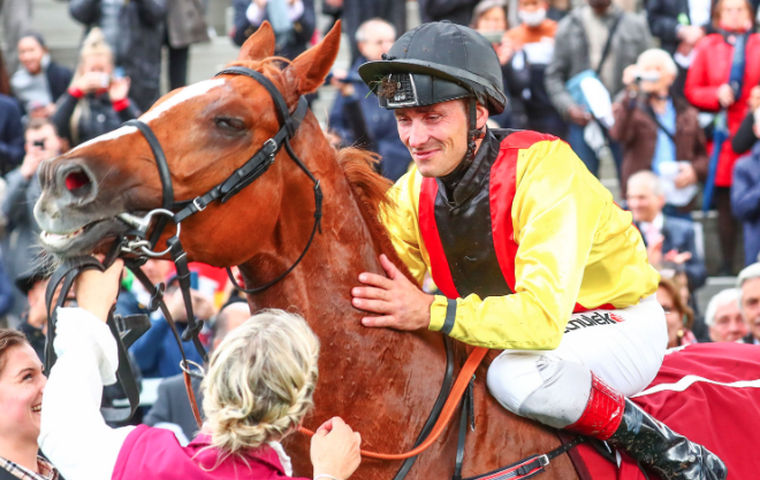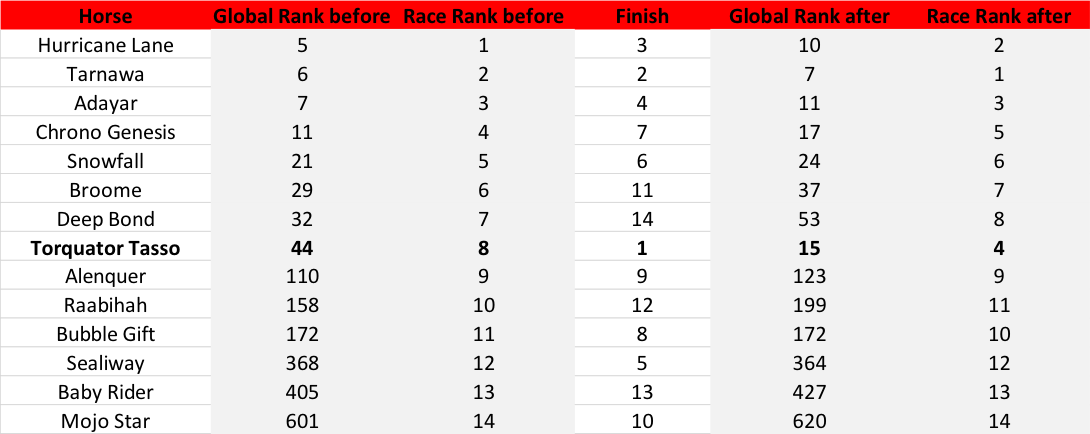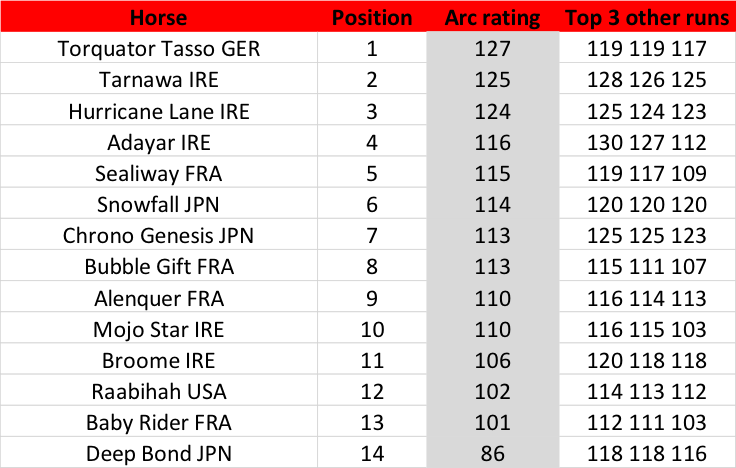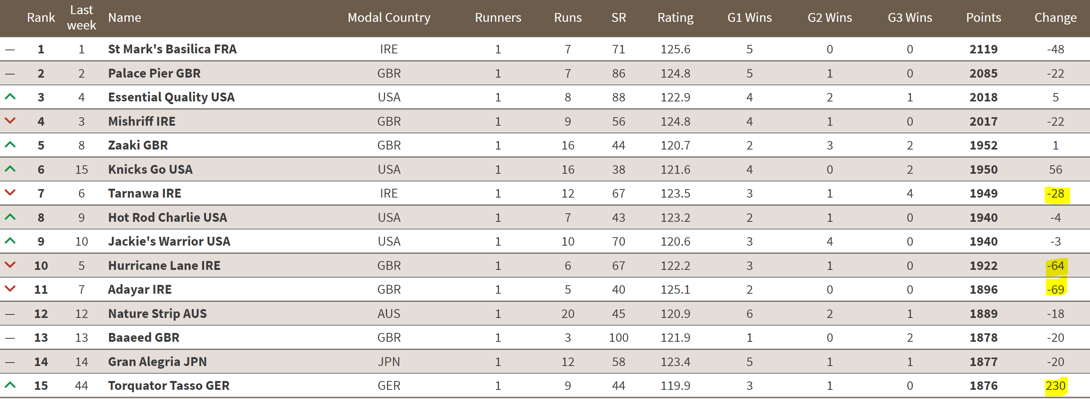
The 2021 G1 Prix de l’Arc de Triomphe told us not just that Torquator Tasso is better than widely presumed, but also that his rivals are perhaps not as good as we reckoned.
This is how the TRC Global Rankings algorithm has treated the result; this is the most logical inference because other explanations are either too fanciful or subjective for the unbiased estimations of a computer.
If a handicap system continues to promote every winner above the existing elite, it suffers the problem of upward drift and has to artificially manipulate the population down again at regular intervals. TRC Global Rankings never has this problem which continues to bedevil human-operated systems all round the world.
Our rankings try to establish a hierarchy of talent that best explains the results of Group and Graded races – bearing in mind their recency. Notice we don’t depend on the race’s reputation or previous standard unless there just isn’t any form to go on, such as when rating contests between previously untested young horses.
The following graphic shows the order in which we ranked the runners entering the race, their finishing position and how we ranked them afterwards:

Does this sound like a race where randomness played a large part? The horses ranked 1-2-3-4-5 finished 3-2-4-7-6, while the horses ranked 10-11-12-13-14 finished 12-8-5-13-10. And only two horses – the winner and fifth-placed Sealiway – exceeded their projection in any meaningful way.
Furthermore, although Torquator Tasso was ranked behind seven runners entering the race, we still had him comfortably within the world’s Top 50. This is because he had already won two G1s and a G2 in his native Germany.
In common with Japan, German racing is focussed on racing at middle distances and beyond. Their breeding industry has long made an admirable stance against horses to have raced on medication, and trainers tend to give horses time to mature and prove their worth. As a result, it is often the case that horses with form in German races tend to improve as they tackle better races elsewhere in Europe. Arc winners Marienbard (2002) and Danedream (2011) have followed this trend before Torquator Tasso.
How good was the winner’s performance? We measure a horse’s performances on the same scale of the World’s Best Racehorse Ratings, which are the sport’s de facto official figures. On our fully automated system, TRC Computer Race Ratings, Torquator Tasso earned a rating of 127, which is even a shade above average for all winners of the Arc during the 11-year (2011-2021) TRC era:

The ground at ParisLongchamp was described officially as heavy. This is almost certainly an exaggeration of the state of conditions; times on the day strongly pointed towards the surface being no worse than soft. As we have highlighted, plenty of horses gave their running on the day, so to use the official description of the ground as justification for caution over the Arc result is a bogus.
A more detailed look at how the Arc field rated using performance ratings gives a clue to how a computer rates a race like the Arc:

According to the figures, Torquator Tasso peaked while every other runner was not quite at their best. Soft going is a legitimate excuse for some, particularly the Japanese pair Chrono Genesis and Deep Bond, while others would have failed to reproduce their best simply because they were in too deep and ran the race inefficiently by trying to chase better horses while flat out.
The computer doesn’t rate the race any differently because it is the Arc. Instead, it finds a rating for the race by choosing a set of performance figures for all races in the database which fit the data best and cause the variation in performance figures for each horse to be minimised.
See how the best figures for each horse tend to cluster together but are rarely all the same (Snowfall is an exception)? This is because of an important principle of handicapping at the mathematical level: Races should be rated around several horses (by allowing them to vary around a notional mean) not through one (the egregious practice of ‘stemming’ or choosing a ‘marker horse’).
Handicapping is merely an optimisation exercise, if you know how that works in applied maths; the computer tries to learn how to pick winners using past ratings - knowing that it is impossible to always be correct - but working to minimise mistakes.
Finally, the TRC algorithm uses all the tools for handicapping at its disposal to arrange the world’s best horses in a hierarchy that is the final ranking. We know the computer is going to have to assign a higher rank than #44 to Torquator Tasso, but how does it decide how high?
When a lower-ranked horse causes an upset, it pays the computer to find a compromise between moving it up the hierarchy and moving others it surprisingly defeated downwards. The more established is a horse’s form, the more reluctant the computer is to shift it a long way from its current perch, though there are a few clever tricks in detecting when a horse has declined due to age or has improved after a change of trainer, say.
Here, it turns out that the set of ratings for all horses that is most consistent with all the results is achieved by ranking Torquator Tasso in front of every horse he defeated in the Arc - with the exception of the former world #5, #6 and #7 Hurricane Lane, Tarnawa and Adayar.
The basic reason for this is given by the previous paragraph: They are peak-year runners with very strong, established form that would create inconsistencies in the rankings if they were relegated too far. As things stand, all three lose rankings points (whose ordering produced the classifications) as shown by a snapshot of this week’s top horses:
The computer expected Hurricane Lane to defeat Tarnawa, so the fact that the opposite happened (albeit narrowly) leads to Hurricane Lane losing more ranking points than the Irish filly. This is facilitated by the Godolphin colt’s best efforts being wide-margin wins of uncertain value, so they can easily be downrated a little.
Adayar, who finished fourth after being sent for home early in the straight, must be a rather confusing horse to rank for the computer – his two best efforts (victories in the G1 Derby at Epsom and the G1 King George at Ascot) are absolutely top-notch, but he has fallen someway below that form in other tries. As a result, he could fit into the rankings in a wide variety of places, but placing him at #11 is the most optimal.
No change at the top of the rankings
The 2021 Arc was a strongly contested renewal – the result of a race should never affect the way we assess that – but maybe it was not quite as strong as it looked.
Indeed, it looked a strong possibility that the result would have a more significant impact on the standings at the very top of the TRC Global Horse Rankings, with St Mark’s Basilica, the Aidan O’Brien-trained winner of the French 2000 Guineas, French Derby, Eclipse Stakes and Irish Champion Stakes this year, likely to lose his place as world #1. That didn’t happen.
Assessing racehorses requires an aversion to the fault of overfitting – making the rankings fit the latest results a little too snugly – but a proportionate response to the Arc is that the bar was not quite as high as it looked for Torquator Tasso and, as a German horse with toughness and stamina on his side, it is clear (with the benefit of hindsight) that we should all have paid him a little more attention.



